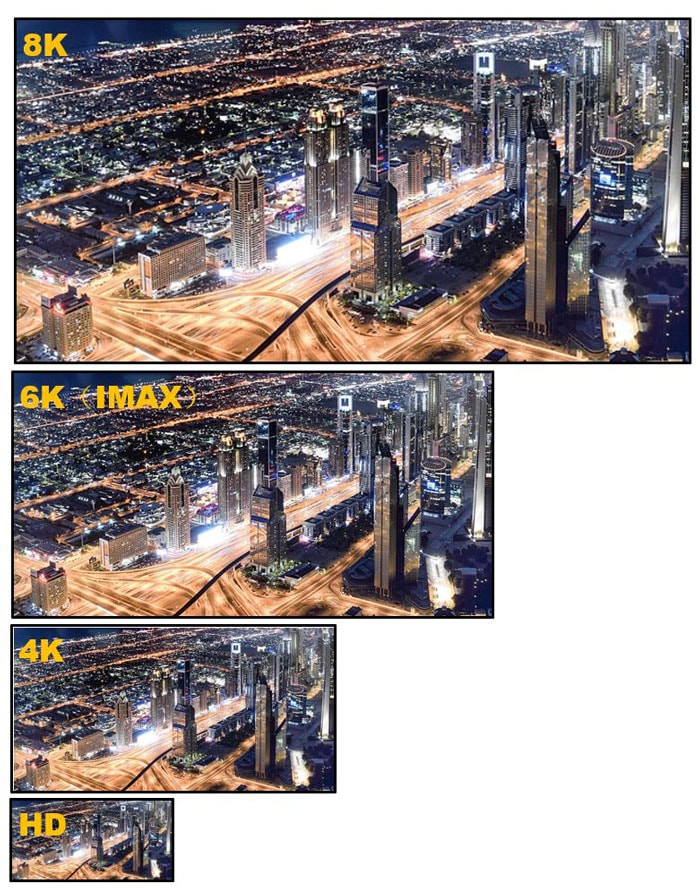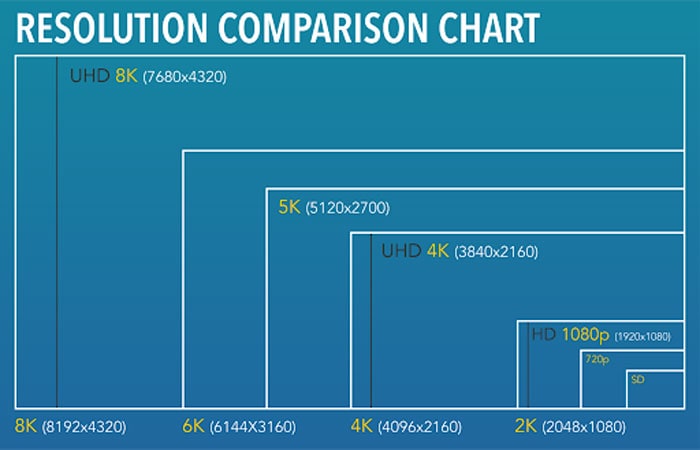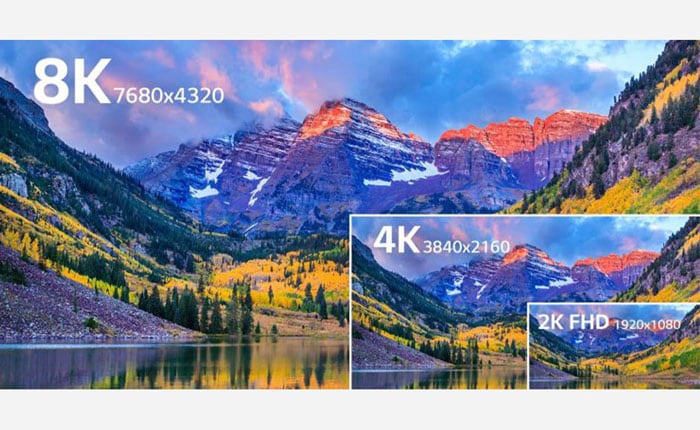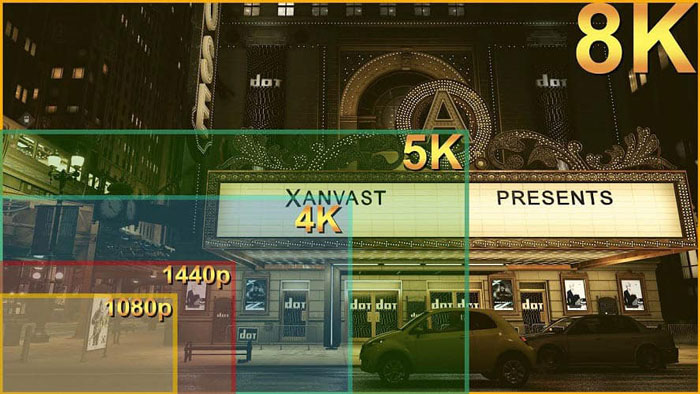Resolution from 4K to 8K: What’s the Difference and How To Choose?
In today's high-definition (HD) society, the demand for crisp, detailed visuals is ever-increasing. With the emergence of resolutions from 4K to 8K, the world of HD is expanding rapidly, offering a more immersive and engaging experience for viewers. But how do you determine which resolution is the perfect fit for your project? In this blog post, we'll delve into the world of 6K resolution and compare it with other popular resolutions from 4K to 8K to help you make an informed decision. Stay tuned as we dive into the world of high-definition and help you unlock the full potential of your visual content.
Part 1: What Is 4K, 6K, and 8K Resolution?
Before we can talk about what these various video resolutions mean, let's discuss a little bit of what video resolution is. So, what is the video resolution?
Video resolution is a measure of quality that refers to the number of pixels or samples used per inch in either height, width, or both dimensions. The higher the pixel count, the better it will look on your screen and video player.
In simple terms, you need more pixels for greater detail because images are made up of tiny dots called "pixels." A lower-resolution image has fewer pixels across an axis, so there's less information available about what those small dots represent - it could be anything from dirt to a car door handle.

Currently, most of us are familiar with 4K, 6K, and 8K resolutions. Let's define them one by one:
- 4K Resolution: K resolution is a display resolution of 3840 x 2160. That means it has four times as many pixels on the horizontal and vertical lines than an HDTV (1920 x 1080). This makes for great detail in movies, games, or television shows.
- 6K Resolution: 6K resolution is a standard in the motion-picture industry and is used by some television broadcasters. 6K resolution has 6144 horizontal pixels, or roughly four times that of HDTV (1920 x 1080).
- 8K Resolution: An 8K resolution is a display resolution of 7680 x 4320. It also has four times more pixels than HDTVs. For those who want to make large prints that are highly detailed, this can be really helpful. This makes for great detail in movies, games, or television shows. But these resolutions come with tradeoffs - they require higher processing power and bandwidth than other forms because there's so much information being processed at once: twice as much height and width as HD TV displays but twice as much detail.

Part 2: What are the Resolution Differences?
Let's start with the basics.
Resolution is a measure of how many pixels there are on your screen in one given space. The more pixels you have, the higher resolution you're going to be able to see. But it will also mean that it takes up more hard drive space and won't look as good if we try viewing this high-resolution content on a smaller device like an iPhone or iPad.
This means that for most people reading this article, anything over 720p resolution should do just fine because chances are their computer monitor or TV has at least 1080p resolution anyways.
And now let's dive into some numbers: what exactly is 2K, 4K, 8K, or 1080p or Full HD?

Before 4K became common, 2K resolution was rare. It was only used in cinema presentations, and most cinemas use 2k resolution (although some are less). The resolution is 2048 x 1080 pixels. But now, as 4K TVs become more and more popular, "2K" is quickly becoming a common shorthand for 1080p high definition.
8K resolution displays images in higher detail than 4K. 1080p screens display at a resolution of 1,920 by 1,080 pixels while 4K displays quadruple those numbers to 3,840 by 2,160. This gives an 8K resolution of 7,680 by 4,320. That's four times the number of pixels as 4K, and it's 16 times that of a 1080p TV.

In order to fully understand the concept, take a couple of steps back from your TV. Try to find a single-pixel (not one of the three subpixels (red, green, and blue lights that make up the screen). If you are looking at a 4K screen, four pixels will take up one-pixel space. If you are looking at a 1080p screen, 16 pixels will fill up 1 pixel. That's 8K. This means 8K is much sharper than 4K and much brighter than 1080p.
Accidentally lost important high-resolution photos/videos?
No worries. Wondershare Recoverit can get back your lost photos within 3 steps.The ultimate and professional data recovery tool is totally reliable and 100% safe.
Part 3: 4K vs. 6K vs. 8K - Which Should I Choose?
If you're looking for the best resolution for your needs, it's essential to know what kind of device you are using. A 4k TV is perfect for gamers and people who want a sharp image on their screen, but 8K TVs give a much more lifelike picture. If you're buying a camera, many factors come into play when deciding which resolution will be best suited to your needs - from the size of the sensor to whether or not you need 4k video recording.
So let's recap what we learned here about resolutions for TVs, videos, games, and cameras.
For TVs:
There are many different sizes and shapes of monitors available on the market today. From small 24 "TVs all the way up to giant 70" UHDTVs, there's something for everyone out there, no matter your budget (or living room size). But monitor manufacturers have started calling them by their actual pixel count instead; HDTVs with 1920 resolution or bigger are considered "Full HD"; while smaller ones have a lower resolution, like 1360x768, 1024x768.

The higher resolution you have on your TV, the more detail it can show in images (though this may vary based on how close or far you are sitting). Although 1080p HDTV should be enough for most people, if you ask the question of the moment is whether 4K or 8K resolution is better for viewing. We suggest you choose something bigger with better pixels, opt for 4K instead of anything lower than that because they won't add any significant difference to what is already provided by HD and SD resolutions.
For playing games:
PC games are often played at a lower resolution than TVs, with HD monitors usually going as high as 2K and even higher resolutions in recent years.
If you're playing console video games, it's important that your TV can support whatever video output is being used by your gaming system. For example, suppose I'm using my Nintendo Switch while sitting about five feet away from my TV, which only supports 720p screens. In that case, I'll just be seeing a blurry picture no matter what setting I use for brightness or contrast settings when adjusting colors.
Therefore, it's also important to consider whether games require high graphics resolutions and frame rates. If not, then even an older gaming console such as PSX has a pretty good performance at standard definition.

For videos:
When it comes to videos, there are many factors that determine what resolution you need. Resolution can impact your ability to see details in the picture when watching HD or UHD videos, especially if viewing from close up. Still, for some people, the higher resolutions won't make any difference whatsoever.
While it is not always necessary to watch videos in the highest resolution. For instance, a high-resolution video on YouTube might be better suited for viewing on your TV than it is when watching online because of buffering issues.
For cameras:
Resolution may not have as much of an effect on camera quality if "megapixels" or other factors are more important considerations. A lower pixel count means you can get away using less expensive lenses and still achieve sharp images. Cameras that record in 4K (and so on) are usually more expensive.

If you're buying a camera instead of using your phone's built-in one for the first time, you'll want to know these resolutions because they will affect how big and clear your pictures will turn out. For example, if I am taking an outdoor picture with my smartphone at 1440p and then take another with my DSLR (which has a higher resolution), the DSLR photo will be much larger than what was on my phone screen even though both were taken from the same distance away. The difference is that smartphones measure their pixels based on displays, whereas DSLRs measure theirs based on the number of photosites built within their sensors.
Of course, whatever resolution of the video you're watching or recording, there is always the risk of your videos getting corrupted or damaged. If that happens, don't get frustrated about your precious funny or memorable videos being lost forever. There are video repair software to address this issue, and the Wondershare Repairit is the best one. This video repair tool is fantastic, with advanced features for repairing video files in various formats like MOV, MP4, M4V, MKV, AVI, FLV, and more. Additionally, it has an intuitive and friendly modern UI and can also repair Full HD, 4K, and 8K videos from any device.
Try it for free at the button below:
Related reading:
Wrap up
In conclusion, choosing the optimal resolution for your project, whether it's 4K, 6K, or 8K, ultimately depends on your specific needs and desired video experience. As we've discussed, resolution defines the level of detail a screen can display, and with the introduction of 6K resolution size, the options for high-definition visuals have expanded.
Today, the two primary resolutions are 1080p (2160 x 1080) and 4K (3840 x 2160), but the emergence of 6K resolution (5760 x 3240) offers a higher level of detail and clarity for those seeking an enhanced visual experience. When deciding between 4K, 6K resolution, and 8K, it's essential to consider factors such as processing power, bandwidth, and the specific requirements of your project.
People Also Ask
-
1. What happens if I play an 8K video on a 4K screen?
Well, this depends on whether you're watching 8K content on a computer or TV screen. Most PCs can play videos from a wide range of resolutions, mainly by rescaling the original resolution to the monitor if your PC has enough CPU or GPU. The video player will decode the 8K video using the GPU and downsample the 8K frames to 4K, or 2K- whatever display resolution you have. If you're playing on a 4K TV that wasn't designed to handle 8K, it's highly like that your TV won't accept any 8K input. Even if it does, it will most likely downsample it to its original screen resolution. The picture quality won't be that good, and you'll experience dropped frames.
-
2. How to repair corrupted 4K/6K/8K videos?
Typically video files get damaged o corrupted during saving, recording, editing, converting, transferring, or processing. Besides, viruses and malware can also corrupt or damage the files. There are various video repair tools to fix corrupted video files, but
Wondershare Repairit is one of the best. This video repair tool has powerful features that can recover and repair Full HD and 4K videos, as well as other video file formats. So, feel free to download it and try it.
-
3. Can I upscale 4K to 8K?
Yes, you can upscale a video resolution from 4K to 8K is possible by using a combination of hardware and software like the Wondershare Video Repair tool. This upscaled 8K video won't have the image quality and sharpness of a native 8K video, but it should offer a relatively better image quality than a full HD 1080p video.
Solve Media File Problems
- Recover & Repair Photos
- Recover & Repair Videos
- Recover & Repair Audio
- Recover & Repair Cameras















Eleanor Reed
staff Editor